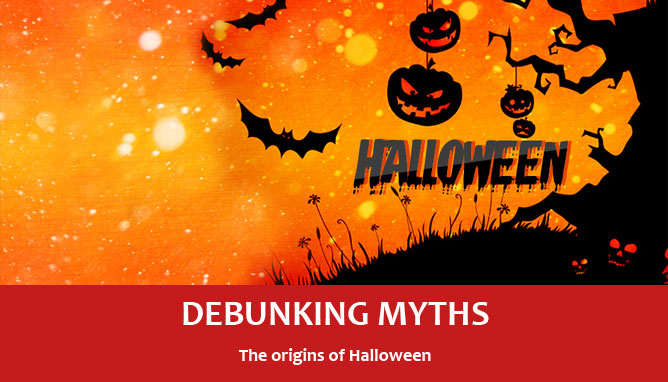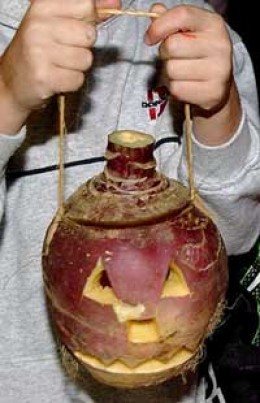DEBUNKING MYTHS – The origins of Halloween


I loved Halloween ever since I was a kid. The tricks, the treats, the magic in the air. Those were the wonder years of my childhood, when a simple blanket with two holes on it could become the perfect Halloween night costume.
It is also the time when the usual unfounded accusations come to life – “Halloween is satanic”, “it plagiarizes the children’s minds”, “it’s an American-made fraud”. So, rather than debunk all of these ill argumentations that have unfortunately extended here to Italy, I’ll try my best to summarize the origins of the “joyously frightful night” in this page.
First and foremost, let’s start from the name. “Halloween” is a contraction of three words, “All Hallows Evening”. “Hallow” is English archaic for “saint” and it is also a verb with the meaning of “sanctify” – you can find this word in the “Our Father” prayer. (And in an amazing Iron Maiden song, by the way). Originally, Halloween was a seasonal Gaelic celebration known as Samhain, which marked ‘the end of the harvest season’ (summer) ‘and the beginning of the “darker half” of the year’ (Wikipedia). The original celebration had pagan, pre-Christian roots, but with the advent of Christianity in the Anglo-Saxon regions, the original pagan festival was then taken over by the more Christian-grounded “allhallowtide“. This syncretism was facilitated by the similarities between the two: in fact, both celebrations involved fearing the unquiet dead and offerings to ease their souls. This eventually evolved into the devotion of the departed.
So, is Halloween “made in America”, or, “a commercial celebration”? Of course. Not! Other than its Gaelic origins, several forms of traditions have been tracked and attested over the years. Scottish poet Robert Burns wrote “Halloween” as a description of the atmosphere surrounding it, which was in turn inspired by a poem written by John Mayne from Dumfries, in 1780. Guess what strikes the most out of the poem?
A things prepared in order due
Gosh guide’s what fearfu pranks ensue!
Some i the kiln pat thraw a clue at whilk bedeen
Then sweethearts at the far end pu at Halloween
So, pranks were well known in the XVIII century, and we may consider the “treats” as an evolution of the original treats given to the unfriendly:
The Celts believed the souls of the dead roamed the streets and villages at night. Since not all spirits were thought to be friendly, gifts and treats were left out to pacify the evil and ensure next years crops would be plentiful. This custom evolved into trick-or-treating.
Just to make a few more examples, some country offer a regional variation of the festival. Focusing on Italy, regional festivals devoted to the cult of the deceased are named Is Animmeddas, Su mortu mortu, Su Peti Cocone, Su Prugadoriu and Is Panixeddas in Sardinia (names according to regional dialectical differences); lest we forget the “fucacos” in Friuli.
Once and for all, Halloween is not american… except for one tiny detail. During the celebration in Ireland and in Scotland, turnips were carved in order to make the traditional jack-o’-lanters. When they arrived on the American shores, Irish and Scottish immigrants couldn’t easily find turnips to carve, so they resorted to the more available pumpkins. This proved to be the best choice, since pumpkins were larger and easier to carve than a turnip. Here’s how it would have looked like.

Is Halloween a “satanic” celebration “plagiarizing the young and innocent”? No, by all means. The term “satanism” has been broadened in meaning by fear-mongering scholars to force the idea of “preserving Christian roots” in the more conservative countries, especially in America. Unfortunately, whilst being only a loud minority, this has been expanding over the ignorant “thanks” to viral images shared over Facebook and sites on the Internet. Truth of the matter is, Halloween is in no way linked to Satanism. Just because a couple of stupid apes browse through towns seeking and torturing black cats for their unspeakable acts of cruelty, it doesn’t mean it’s a “satanic” event. This kind of things is just sadistic and stupid, and in no way represents the spirit of Halloween.
Just so you know, Halloween is the night where our fear of dying is mocked and ridiculed. We all live with the fear of dying one day or another – we fear what we do not know, nor timely expect. Over the years, civilization has been building up stories about what could possibly cause us death: witches, warlocks, ghosts, mummies, zombies, ghouls; killer clowns, blood-thirsty vampires, global pandemic, you name it. Making a mockery out of something you fear is not satanic in any way possible. It’s a way of telling yourself how stupid it is to be living in fear. Just for one day, you focus on the irrational side of death, and laugh on it. If anything so mysterious or inevitable can be ridiculed just for one night, then there’s nothing much to fear. It bears similarities with Mardi Gras: the festival was born with the idea of ridiculing the power and the authorities, showing stereotypes to point at and laugh. Again, if anything so mysterious or inevitable can be ridiculed in some way, then there’s nothing much to fear, because it shows the human side of it – along with its weaknesses.
It’s not about candy, masks or parties – it’s about overcoming the fear of the unknown.
I wrote this article in hopes to stop the hoaxes surrounding this beautiful time of the year. Meanwhile, I hope you spent some quality time with your friends or relatives.
Until next time 🙂
Se il nostro servizio ti piace sostienici su PATREON o
con una donazione PAYPAL.






